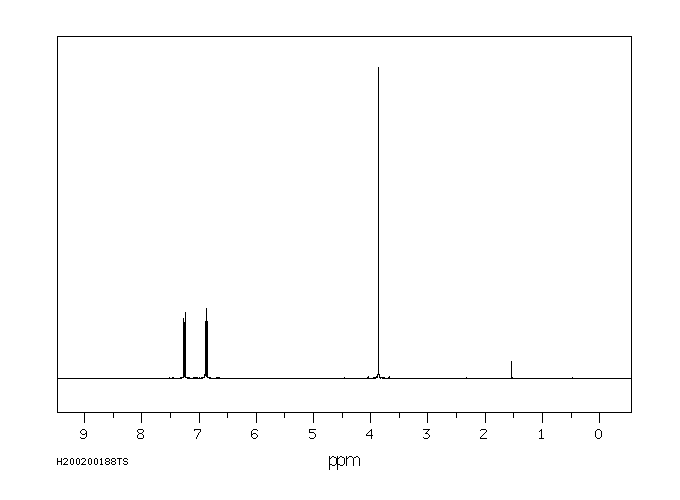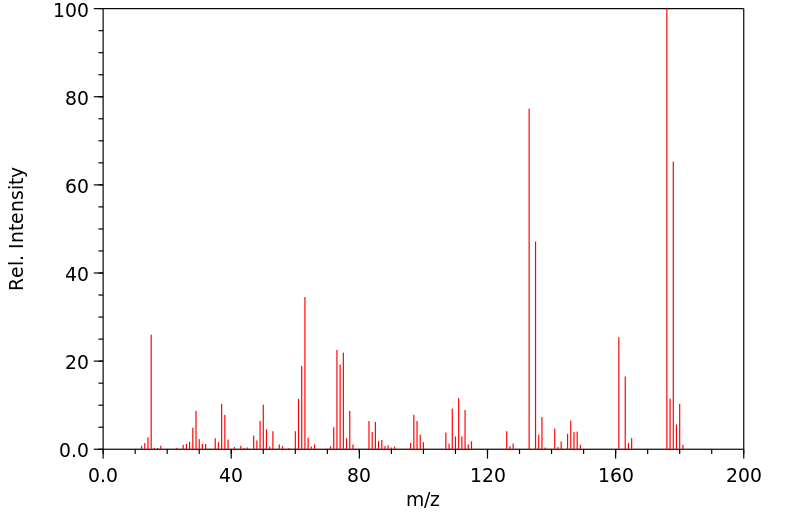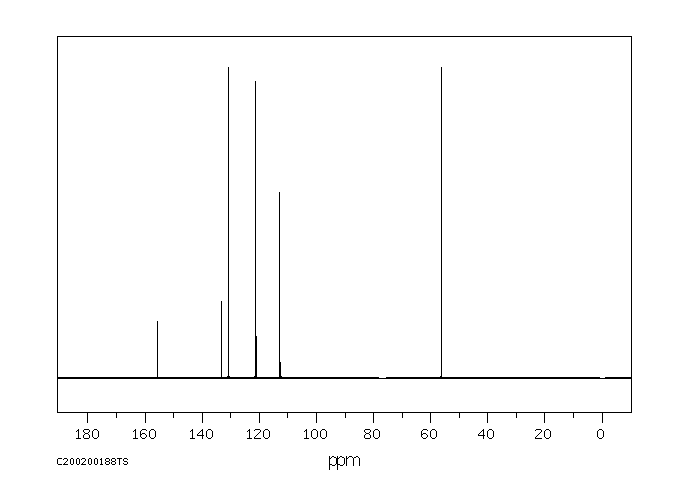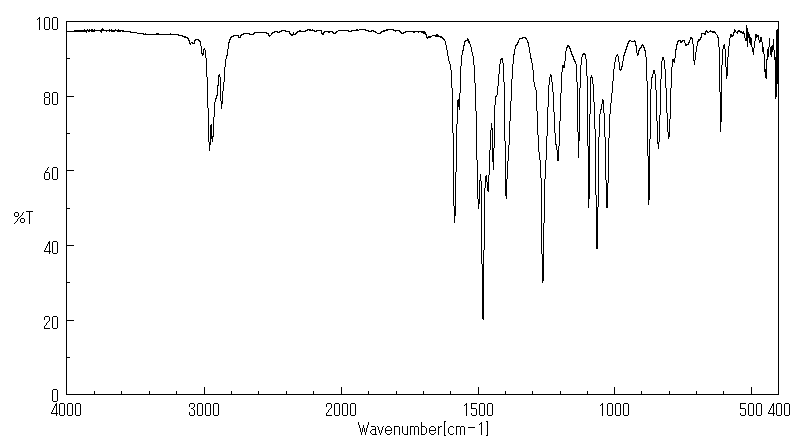2,5-二氯苯甲醚 | 1984-58-3
中文名称
2,5-二氯苯甲醚
中文别名
——
英文名称
2,5-dichloroanisole
英文别名
1,4-dichloro-2-methoxybenzene;2,5-Dichlor-anisol;2,5-dichlorophenol methyl ether
CAS
1984-58-3
化学式
C7H6Cl2O
mdl
MFCD00061123
分子量
177.03
InChiKey
QKMNFFSBZRGHDJ-UHFFFAOYSA-N
BEILSTEIN
——
EINECS
——
-
物化性质
-
计算性质
-
ADMET
-
安全信息
-
SDS
-
制备方法与用途
-
上下游信息
-
文献信息
-
表征谱图
-
同类化合物
-
相关功能分类
-
相关结构分类
物化性质
-
熔点:24°C
-
沸点:128-132°C 3,5mm
-
密度:1.33
-
闪点:21°C
-
物理描述:Liquid
-
保留指数:1244;1254;1260;1256;1264;1273;1239;1241;1250.9
-
稳定性/保质期:
如果按照规格使用和储存,则不会分解,没有已知的危险反应,应避免与氧化物接触。
计算性质
-
辛醇/水分配系数(LogP):3.3
-
重原子数:10
-
可旋转键数:1
-
环数:1.0
-
sp3杂化的碳原子比例:0.142
-
拓扑面积:9.2
-
氢给体数:0
-
氢受体数:1
安全信息
-
TSCA:Yes
-
危险品标志:Xn,Xi
-
安全说明:S23,S26,S37/39
-
危险类别码:R36/37/38
-
海关编码:2909309090
-
危险品运输编号:UN 1993
-
危险性防范说明:P261,P305+P351+P338
-
危险性描述:H315,H319,H335
-
储存条件:密封,在2°C至-8°C下保存
SDS
| Name: | 2 5-Dichloroanisole 99% Material Safety Data Sheet |
| Synonym: | 1,4-Dichloro-2-Methoxybenzene |
| CAS: | 1984-58-3 |
Synonym:1,4-Dichloro-2-Methoxybenzene
Section 2 - COMPOSITION, INFORMATION ON INGREDIENTS
| CAS# | Chemical Name | content | EINECS# |
| 1984-58-3 | 2,5-Dichloroanisole | 99 | 217-852-6 |
Risk Phrases: None Listed.
Section 3 - HAZARDS IDENTIFICATION
EMERGENCY OVERVIEW
The toxicological properties of this material have not been fully investigated.
Potential Health Effects
Eye:
May cause eye irritation.
Skin:
May cause skin irritation.
Ingestion:
May cause irritation of the digestive tract. The toxicological properties of this substance have not been fully investigated.
Inhalation:
May cause respiratory tract irritation. The toxicological properties of this substance have not been fully investigated.
Chronic:
No information found.
Section 4 - FIRST AID MEASURES
Eyes: Flush eyes with plenty of water for at least 15 minutes, occasionally lifting the upper and lower eyelids. Get medical aid.
Skin:
Get medical aid. Flush skin with plenty of water for at least 15 minutes while removing contaminated clothing and shoes. Wash clothing before reuse.
Ingestion:
Never give anything by mouth to an unconscious person. Get medical aid. Do NOT induce vomiting. If conscious and alert, rinse mouth and drink 2-4 cupfuls of milk or water.
Inhalation:
Remove from exposure and move to fresh air immediately. If not breathing, give artificial respiration. If breathing is difficult, give oxygen. Get medical aid.
Notes to Physician:
Section 5 - FIRE FIGHTING MEASURES
General Information:
As in any fire, wear a self-contained breathing apparatus in pressure-demand, MSHA/NIOSH (approved or equivalent), and full protective gear. During a fire, irritating and highly toxic gases may be generated by thermal decomposition or combustion. Use water spray to keep fire-exposed containers cool. Vapors may be heavier than air. They can spread along the ground and collect in low or confined areas. Containers may explode when heated.
Extinguishing Media:
Use agent most appropriate to extinguish fire. Cool containers with flooding quantities of water until well after fire is out. Use water spray, dry chemical, carbon dioxide, or appropriate foam.
Section 6 - ACCIDENTAL RELEASE MEASURES
General Information: Use proper personal protective equipment as indicated in Section 8.
Spills/Leaks:
Absorb spill with inert material (e.g. vermiculite, sand or earth), then place in suitable container. Avoid runoff into storm sewers and ditches which lead to waterways. Clean up spills immediately, observing precautions in the Protective Equipment section. Provide ventilation.
Section 7 - HANDLING and STORAGE
Handling:
Wash thoroughly after handling. Remove contaminated clothing and wash before reuse. Use with adequate ventilation. Avoid contact with eyes, skin, and clothing. Keep container tightly closed. Avoid ingestion and inhalation.
Storage:
Store in a tightly closed container. Store in a cool, dry, well-ventilated area away from incompatible substances.
Section 8 - EXPOSURE CONTROLS, PERSONAL PROTECTION
Engineering Controls:
Facilities storing or utilizing this material should be equipped with an eyewash facility and a safety shower. Use adequate ventilation to keep airborne concentrations low.
Exposure Limits CAS# 1984-58-3: Personal Protective Equipment Eyes: Wear appropriate protective eyeglasses or chemical safety goggles as described by OSHA's eye and face protection regulations in 29 CFR 1910.133 or European Standard EN166.
Skin:
Wear appropriate protective gloves to prevent skin exposure.
Clothing:
Wear appropriate protective clothing to prevent skin exposure.
Respirators:
A respiratory protection program that meets OSHA's 29 CFR 1910.134 and ANSI Z88.2 requirements or European Standard EN 149 must be followed whenever workplace conditions warrant respirator use.
Section 9 - PHYSICAL AND CHEMICAL PROPERTIES
Physical State: Liquid
Color: clear very slight yellow
Odor: None reported.
pH: Not available.
Vapor Pressure: Not available.
Viscosity: Not available.
Boiling Point: Not available.
Freezing/Melting Point: Not available.
Autoignition Temperature: Not available.
Flash Point: Not applicable.
Explosion Limits, lower: Not available.
Explosion Limits, upper: Not available.
Decomposition Temperature:
Solubility in water:
Specific Gravity/Density: 1.3330g/cm3
Molecular Formula: C7H6Cl2O
Molecular Weight: 177.03
Section 10 - STABILITY AND REACTIVITY
Chemical Stability:
Stable under normal temperatures and pressures.
Conditions to Avoid:
Incompatible materials, excess heat, strong oxidants.
Incompatibilities with Other Materials:
Oxidizing agents.
Hazardous Decomposition Products:
Hydrogen chloride, carbon monoxide, irritating and toxic fumes and gases, carbon dioxide.
Hazardous Polymerization: Has not been reported.
Section 11 - TOXICOLOGICAL INFORMATION
RTECS#:
CAS# 1984-58-3 unlisted.
LD50/LC50:
Not available.
Carcinogenicity:
2,5-Dichloroanisole - Not listed by ACGIH, IARC, or NTP.
Section 12 - ECOLOGICAL INFORMATION
Section 13 - DISPOSAL CONSIDERATIONS
Dispose of in a manner consistent with federal, state, and local regulations.
Section 14 - TRANSPORT INFORMATION
IATA
Not regulated as a hazardous material.
IMO
Not regulated as a hazardous material.
RID/ADR
Not regulated as a hazardous material.
Section 15 - REGULATORY INFORMATION
European/International Regulations
European Labeling in Accordance with EC Directives
Hazard Symbols: Not available.
Risk Phrases:
Safety Phrases:
S 24/25 Avoid contact with skin and eyes.
S 28A After contact with skin, wash immediately with
plenty of water.
S 37 Wear suitable gloves.
S 45 In case of accident or if you feel unwell, seek
medical advice immediately (show the label where
possible).
WGK (Water Danger/Protection)
CAS# 1984-58-3: No information available.
Canada
CAS# 1984-58-3 is listed on Canada's NDSL List.
CAS# 1984-58-3 is not listed on Canada's Ingredient Disclosure List.
US FEDERAL
TSCA
CAS# 1984-58-3 is listed on the TSCA inventory.
SECTION 16 - ADDITIONAL INFORMATION
N/A
上下游信息
-
上游原料
中文名称 英文名称 CAS号 化学式 分子量 3-氯苯甲醚 1-chloro-3-methoxy-benzene 2845-89-8 C7H7ClO 142.585 2,5-二氯苯酚 2,5-dichlorophenol 583-78-8 C6H4Cl2O 163.003 -
下游产品
中文名称 英文名称 CAS号 化学式 分子量 —— chloromethyl-(2,5-dichloro-phenyl)-ether 875246-32-5 C7H5Cl3O 211.475 2-氯苯甲醚 2-Chloroanisole 766-51-8 C7H7ClO 142.585 2,4,5-三氯苯甲醚 2,4,5-trichloroanisole 6130-75-2 C7H5Cl3O 211.475 2,3,6-三氯苯甲醚 2,3,6-trichloroanisole 50375-10-5 C7H5Cl3O 211.475 3-氯苯甲醚 1-chloro-3-methoxy-benzene 2845-89-8 C7H7ClO 142.585 2,5-二氯苯酚 2,5-dichlorophenol 583-78-8 C6H4Cl2O 163.003 1-氯-2,4-二甲氧基苯 1-chloro-2,4-dimethoxybenzene 7051-13-0 C8H9ClO2 172.611 —— 2,5-dichloro-4-methoxybenzaldehyde 381229-74-9 C8H6Cl2O2 205.04 3-甲氧基-4-氯苯胺 4-chloro-m-anisidine 13726-14-2 C7H8ClNO 157.6
反应信息
-
作为反应物:描述:参考文献:名称:HMPA中未活化的芳基卤化物与甲醇钠的反应:酚,茴香醚和甲氧基酚的合成摘要:由于S N Ar过程,甲醇钠与HMPA中的二氯苯反应生成氯茴香醚。然后过量的MeONa通过S N 2反应使醚脱甲基,得到氯酚。用三氯苯和四氯苯可以将最初形成的氯茴香醚脱烷基化为氯酚,或者可以进一步取代生成氯二甲氧基苯;它们与过量的MeONa反应,得到氯甲氧基苯酚。在取代基的电子效应的基础上,介绍并讨论了用二,三和四氯苯的各种异构体获得的结果。DOI:10.1016/s0040-4020(01)97647-1
-
作为产物:描述:alkaline earth salt of/the/ methylsulfuric acid 在 copper chloride 作用下, 生成 2,5-二氯苯甲醚参考文献:名称:Reverdin; Eckhard, Chemische Berichte, 1899, vol. 32, p. 2623摘要:DOI:
文献信息
-
Active Molybdenum-Based Anode for Dehydrogenative Coupling Reactions作者:Sebastian B. Beil、Timo Müller、Sydney B. Sillart、Peter Franzmann、Alexander Bomm、Michael Holtkamp、Uwe Karst、Wolfgang Schade、Siegfried R. WaldvogelDOI:10.1002/anie.201712718日期:2018.2.23and powerful active anode system that can be operated in 1,1,1,3,3,3‐hexafluoro‐2‐propanol (HFIP) has been discovered. In HFIP the molybdenum anode forms a compact, conductive, and electroactive layer of higher‐valent molybdenum species. This system can replace powerful but stoichiometrically required MoV reagents for the dehydrogenative coupling of aryls. This electrolytic reaction is more sustainable发现了一种可以在1,1,1,3,3,3-六氟-2-丙醇(HFIP)中运行的功能强大的新型阳极活性系统。在HFIP中,钼阳极形成一个高价钼物种的致密,导电和电活性层。该系统可替代功能强大但化学计量上要求的Mo V试剂,用于芳基的脱氢偶联。这种电解反应是更可持续的,并允许转化广泛范围的活化芳烃。
-
Sulfonation of chloro- and dichloroanisoles with concentrated aqueous sulfuric acid and sulfur trioxide. Demethylation of chloroanisolesulfonic acids in sulfuric acid systems作者:Peter de Wit、Hans CerfontainDOI:10.1002/recl.19881070605日期:——The nine chloro- and dichloroanisoles have been sulfonated with sulfuric acid. The observed sulfonic acid isomer distributions are determined mainly by the ortho- and para- directing effect of the methoxy substituent. In the reaction with sulfuric acid, the initially formed chloro- and dichloroanisolesulfonic acids are demethylated to give the corresponding phenolsulfonic acids. Demethylation occurs
-
Inhibitors of c-Jun N-terminal kinases申请人:Liu Gang公开号:US20060173050A1公开(公告)日:2006-08-03The present invention relates to compounds that are inhibitors of c-jun N-terminal kinase 1, 2, or 3 (JNK1, JNK2, or JNK3), compositions containing the compounds and the use of the compounds in the prevention or treatment of disorders regulated by the activation of JNK1, JNK2 and JNK3.本发明涉及作为c-jun N-末端激酶1、2或3(JNK1、JNK2或JNK3)抑制剂的化合物,包含这些化合物的组合物以及这些化合物在预防或治疗由JNK1、JNK2和JNK3激活调控的疾病中的用途。
-
[EN] 2-ARYLOXYETHYL GLYCINE DERIVATIVES AND THEIR USE AS GLYCINE TRANSPORT INHIBITORS<br/>[FR] DERIVES DE LA 2-ARYLOXYETHYL GLYCINE ET LEUR UTILISATION COMME INHIBITEURS DU TRANSPORT DE LA GLYCINE申请人:LILLY CO ELI公开号:WO2005100301A1公开(公告)日:2005-10-27The present invention relates to certain 2-aryloxyethyl glycine derivatives that exhibit activity as inhibitors of the glycine type-1 transporter, to pharmaceutical compositions containing them and to their use in the treatment of neurological and neuropsychiatric disorder.
-
NOVEL SUBSTITUTED TRIAZOLE DERIVATIVES AS GAMMA SECRETASE MODULATORS申请人:Van Brandt Sven Franciscus Anna公开号:US20120295891A1公开(公告)日:2012-11-22The present invention is concerned with novel substituted triazole derivatives of Formula (I) wherein Het 1 , R 1 , R 2 , A 1 , A 2 , A 3 , A 4 , L 1 , and L 2 have the meaning defined in the claims. The compounds according to the present invention are useful as gamma secretase modulators. The invention further relates to processes for preparing such novel compounds, pharmaceutical compositions comprising said compounds as an active ingredient as well as the use of said compounds as a medicament.
表征谱图
-
氢谱1HNMR
-
质谱MS
-
碳谱13CNMR
-
红外IR
-
拉曼Raman
-
峰位数据
-
峰位匹配
-
表征信息
同类化合物
(βS)-β-氨基-4-(4-羟基苯氧基)-3,5-二碘苯甲丙醇
(S,S)-邻甲苯基-DIPAMP
(S)-(-)-7'-〔4(S)-(苄基)恶唑-2-基]-7-二(3,5-二-叔丁基苯基)膦基-2,2',3,3'-四氢-1,1-螺二氢茚
(S)-盐酸沙丁胺醇
(S)-3-(叔丁基)-4-(2,6-二甲氧基苯基)-2,3-二氢苯并[d][1,3]氧磷杂环戊二烯
(S)-2,2'-双[双(3,5-三氟甲基苯基)膦基]-4,4',6,6'-四甲氧基联苯
(S)-1-[3,5-双(三氟甲基)苯基]-3-[1-(二甲基氨基)-3-甲基丁烷-2-基]硫脲
(R)富马酸托特罗定
(R)-(-)-盐酸尼古地平
(R)-(-)-4,12-双(二苯基膦基)[2.2]对环芳烷(1,5环辛二烯)铑(I)四氟硼酸盐
(R)-(+)-7-双(3,5-二叔丁基苯基)膦基7''-[((6-甲基吡啶-2-基甲基)氨基]-2,2'',3,3''-四氢-1,1''-螺双茚满
(R)-(+)-7-双(3,5-二叔丁基苯基)膦基7''-[(4-叔丁基吡啶-2-基甲基)氨基]-2,2'',3,3''-四氢-1,1''-螺双茚满
(R)-(+)-7-双(3,5-二叔丁基苯基)膦基7''-[(3-甲基吡啶-2-基甲基)氨基]-2,2'',3,3''-四氢-1,1''-螺双茚满
(R)-(+)-4,7-双(3,5-二-叔丁基苯基)膦基-7“-[(吡啶-2-基甲基)氨基]-2,2”,3,3'-四氢1,1'-螺二茚满
(R)-3-(叔丁基)-4-(2,6-二苯氧基苯基)-2,3-二氢苯并[d][1,3]氧杂磷杂环戊烯
(R)-2-[((二苯基膦基)甲基]吡咯烷
(R)-1-[3,5-双(三氟甲基)苯基]-3-[1-(二甲基氨基)-3-甲基丁烷-2-基]硫脲
(N-(4-甲氧基苯基)-N-甲基-3-(1-哌啶基)丙-2-烯酰胺)
(5-溴-2-羟基苯基)-4-氯苯甲酮
(5-溴-2-氯苯基)(4-羟基苯基)甲酮
(5-氧代-3-苯基-2,5-二氢-1,2,3,4-oxatriazol-3-鎓)
(4S,5R)-4-甲基-5-苯基-1,2,3-氧代噻唑烷-2,2-二氧化物-3-羧酸叔丁酯
(4S,4''S)-2,2''-亚环戊基双[4,5-二氢-4-(苯甲基)恶唑]
(4-溴苯基)-[2-氟-4-[6-[甲基(丙-2-烯基)氨基]己氧基]苯基]甲酮
(4-丁氧基苯甲基)三苯基溴化磷
(3aR,8aR)-(-)-4,4,8,8-四(3,5-二甲基苯基)四氢-2,2-二甲基-6-苯基-1,3-二氧戊环[4,5-e]二恶唑磷
(3aR,6aS)-5-氧代六氢环戊基[c]吡咯-2(1H)-羧酸酯
(2Z)-3-[[(4-氯苯基)氨基]-2-氰基丙烯酸乙酯
(2S,3S,5S)-5-(叔丁氧基甲酰氨基)-2-(N-5-噻唑基-甲氧羰基)氨基-1,6-二苯基-3-羟基己烷
(2S,2''S,3S,3''S)-3,3''-二叔丁基-4,4''-双(2,6-二甲氧基苯基)-2,2'',3,3''-四氢-2,2''-联苯并[d][1,3]氧杂磷杂戊环
(2S)-(-)-2-{[[[[3,5-双(氟代甲基)苯基]氨基]硫代甲基]氨基}-N-(二苯基甲基)-N,3,3-三甲基丁酰胺
(2S)-2-[[[[[((1S,2S)-2-氨基环己基]氨基]硫代甲基]氨基]-N-(二苯甲基)-N,3,3-三甲基丁酰胺
(2S)-2-[[[[[[((1R,2R)-2-氨基环己基]氨基]硫代甲基]氨基]-N-(二苯甲基)-N,3,3-三甲基丁酰胺
(2-硝基苯基)磷酸三酰胺
(2,6-二氯苯基)乙酰氯
(2,3-二甲氧基-5-甲基苯基)硼酸
(1S,2S,3S,5S)-5-叠氮基-3-(苯基甲氧基)-2-[(苯基甲氧基)甲基]环戊醇
(1S,2S,3R,5R)-2-(苄氧基)甲基-6-氧杂双环[3.1.0]己-3-醇
(1-(4-氟苯基)环丙基)甲胺盐酸盐
(1-(3-溴苯基)环丁基)甲胺盐酸盐
(1-(2-氯苯基)环丁基)甲胺盐酸盐
(1-(2-氟苯基)环丙基)甲胺盐酸盐
(1-(2,6-二氟苯基)环丙基)甲胺盐酸盐
(-)-去甲基西布曲明
龙蒿油
龙胆酸钠
龙胆酸叔丁酯
龙胆酸
龙胆紫-d6
龙胆紫










